|
|
|
|||
|
|
||||
|
|
||||
| The (Jet)X Files | ||||
|
|
HOME | SITE MAP | FORUM | CONTACT |
|
||
|
ABOUT | MOTORS | MODELS | ARCHIVE | HISTORY | STORE | FAQ | LINKS
|
|
|
|
|
|
|||||||||||||||||||||||||||||||||||||||||||||||||||||||||||||||||||||
|
The (Jet)X Files 8
(August 2003)
by Roger Simmonds Reprinted from SAM 35 Speaks, August 2003 The history of rocket-propelled model aeroplanes, which began, for our purposes, with Mr F W Thomas in 1907, is much richer and more interesting than I had thought. I have been sent plans of several rocket planes designed in the UK and US before the Second World War, and I will discuss these in a future column. These models might be considered novelties, rather than “serious” designs, but during the war, as other means of propulsion such as elastic and i.c. engines were either in short supply or banned, rocket power, being one way for the adventurous to get their creations into the air, became slightly less disreputable. Laurence Sparey (a well-known modeller of the time) published an article in Model Engineer in 1944, and the story of the home fabrication of his rockets has been amusingly told in SAM Speaks (June and August 1999). The model featured in the 1944 article may have originated in Germany before the War. Not only is it, “unusually graceful and well–proportioned,” it is also quite suitable for Rapier propulsion, and Peter Tolhurst is building one for L2 [right]. Despite Sparey’s article (or perhaps because of it), it was not until after the war that rocket propulsion (which now simulated the turbojet power of the new fighter prototypes) could claim its proper respectability. |
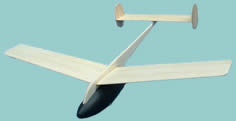
- Peter Tolhurst
|
|||||||||||||||||||||||||||||||||||||||||||||||||||||||||||||||||||||
|
This month’s column reviews the period from just after the war to the appearance of Jetex motors and the first kits for these motors. Howard Boys’ Flaming Ptero [right] has been discussed several times in SAM 35 Speaks, and, I believe, in the first SAM Yearbook. If anyone could send me a copy of this article for the Jetex Heritage Project I would be very grateful. Nick Peppiat has built an 18” version of the Flaming Ptero for Rapier power, so I hope we will soon see this at meetings. There are two interesting addenda to the Flaming Ptero saga. First, Stan Pearson has pointed out that the model was similar to some of Boys’ distinctive rubber powered designs. Was Howard Boys’ interest in flying wings initially stimulated by Sir Frederick Handley Page’s prize of £50, offered in 1945 for a “tailless model, conforming to certain broad conditions, that could win a National Competition”? Secondly, a very similar flying wing, apparently Jetex powered, appeared in a 1951 Swedish magazine (Teknik för Alla), without acknowledgement of its progenitor. Most curious. Howard Boys followed his 1946 “Selwyn B Royston” Rocket Plane, discussed last month, with two very nice designs for the D.H. 100 Vampire [plan available for download] and D.H. 108 Swallow [plan available for download]. These were available from ‘Powakits’, who also sold the motors. I believe the advertisement [above right] has appeared before in SAM 35 Speaks, but not the plans, and I must thank Nick Peppiat for these. Note that the cost of motors in this advertisement (this one is from Aeromodeller, October 1947) is given as 9/- per two dozen (4½ d each), a lot cheaper than they were from Astral (7½ d). I wonder how these prices compare to those of today’s Rapiers at 80-90 pence? The Swallow [right] is an especially pleasing design, though it is not completely accurate, and, as was normal practice in those days, the motor was shoved up the rear end. Boys comments that with the motor here, “the alteration in position of the CG due to the burning of the charge only results in a higher gliding speed … the unit can be directed downwards a little so that the thrust helps to counteract the weight.”
|
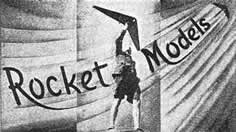
-
Aeromodeller, July 1947, p. 466
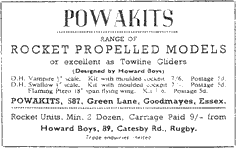
- Aeromodeller, Oct. 1947
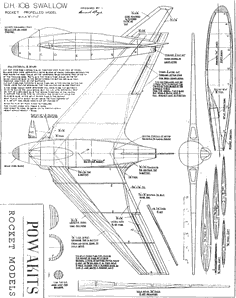
- Powakits
|
|||||||||||||||||||||||||||||||||||||||||||||||||||||||||||||||||||||
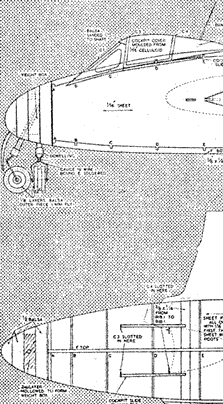
To learn about these, one has to refer to an article written by Howard Boys in the July 1947 Aeromodeller. This makes fascinating reading and deserves to be quoted at greater length than is possible here. I was very pleased that it included the specifications of his two “R.P.” motors. No 1a gave a thrust of ¾ oz. for about five seconds, “suitable for models up to 2 ft. wingspan, providing the weight is no more than about 1 ½ozs.”, whilst No 3 (one wonders what happened to No 2) gave 3 ozs. thrust for 15 seconds. It had “an extra burst for take-off” and was “suitable for models about the Wakefield size”. The R.P. 1a was therefore equivalent to the Rapier L2 HP (or Jetex 50), though with a much shorter burn time. There is as yet no Rapier to match the power of the No. 3, which is a pity, as this would be suitable for the Jetmaster ‘Tailored’ models and the many “PAA-Loader” duration designs. Intriguingly, Boys alludes to “French motors”, which gave “about 7 oz thrust for ten seconds, the size and weight being about the same as our No 3 units”. He mentions a Monsieur Bougeret in the text, and approves of his steep climbing models (I can well believe this with 7 oz. thrust) which were the ”best consistent rocket model flying he had yet seen” [sic]. Does any reader have any knowledge of M. Bougeret and his models? The article includes a sensible discussion of duration models, a warning that motors could explode, and finishes with, “be warned! It is illegal to modify a firework … to use an ordinary skyrocket to drive a model aeroplane would definitely be illegal”. |
|
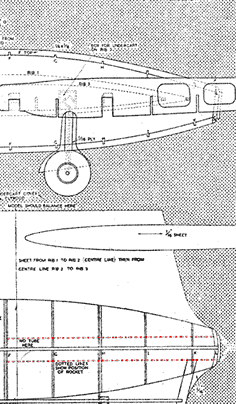
- Aeromodeller, Aug. 1947
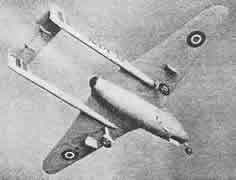
- Aeromodeller, Aug. 1947
|
||||||||||||||||||||||||||||||||||||||||||||||||||||||||||||||||||||
|
I am filled with admiration for Howard Boys and what he achieved. His designs were inspiring, and his motors were the first really practicable form of ‘jet’ propulsion for models. In retrospect, one can see that the ambiguous legal status of the motors and the introduction of Jetex killed off his enterprise. One wishes otherwise, but, ironically, it is the Rapier units of today are the true descendants of these first ‘sustainer’ (that is low thrust, long duration) motors, whilst it is ‘Jetex’ that is, unfortunately, now in something of a limbo. I do hope this will change. The appearance of rocket propelled models did not go unnoticed by the establishment of the time. I have a copy of The New Book of Flight, a most august tome published in 1948. This mainly concerned itself with full size aviation, but there is a chapter on aeromodelling, written by D A Russell. In it he states, “Rocket propulsion has progressed by leaps and bounds. A well-known firm of pyrotechnicians is co-operating with the model aircraft movement in producing special rockets for use with model aircraft to definite thrust equivalents.” “So far tailless models have been employed for the obvious advantage given by the absence of empenage that could be fired by the exploding propulsant.” “Recently a scale model Vampire made its appearance and flew quite well”. This is wonderful stuff indeed. Was the Vampire that flew “quite well” A J Cockle’s design? I suspect so, and to be referred to in a book of this calibre, which was edited by one C H Gibbs-Smith, was to achieve some sort of respectability! |
||||||||||||||||||||||||||||||||||||||||||||||||||||||||||||||||||||||
|
By January 1950, the Wilmot Mansour range included Vampire kits for both the Jetex 50 and 100 (see the advertisement [right]). I believe Veron started to produce Jetex kits in 1949, but didn’t include a Vampire, which is rather a pity, and the slightly later KeilKraft and Skyleada Flying Scale series also ignored the Vampire, preferring the later Venom. So, if one wishes to build a Vampire of the period, one has only (unless any reader knows better) the Cockle, Boys, and Wilmot Mansour plans to chose from. A J Cockle’s design is the most ‘true to scale’, but its size and weight make it the least practicable. At 12 oz. it would have been underpowered by the Powakits No 3 motor, so perhaps Mr Cockle had access to the “7 oz. thrust French motors”. The plan can be reduced to about 13-15" for L2 HP power, but I doubt the all-sheet covering could be replicated at this size without an unacceptable weight penalty. Having said that, I’m sure somebody like Tony Betts will prove me wrong! I myself would not fit a fixed undercarriage (these were, I’m afraid, like exposed cylinder heads and profile models, another youthful dislike of mine). The Boys’ Vampire was smaller (20” span, suitable for L2 HP), and no undercarriage, so I am not sure how it was launched, given the warnings about exploding rockets. Only the wing leading edge is sheeted, but this, as with the Swallow, adds a nice ‘period’ touch to the model. The plan needs expert interpretation at some points, but nevertheless it is a perfectly reasonable proposition. These designs ought to be eligible for the ‘Eddie Riding Cup’, even if Rapier powered, though the motor must, of course, be mounted in the original position. The slightly later Wilmot Mansour design is at first glance quite disappointing (see WM advertisement). The booms are almost twice their scale lengths, there is excessive dihedral, and the wing roots and spars are inadequate. Again, there is no trough, though this was by now a feature of the contemporary Veron models that could have been copied, and the motor is mounted rather inelegantly around the CG in a fuselage cut-out that extends to the jet orifice (represented by a ring of paper). However, the WM design is worth considering. It is the right size for L2 or L2 HP without modification, but, more importantly, there is a nice kit available from Physics of Flight. I bought one in the interests of research. The wood is excellent, all parts are accurately cut out; the canopy is quite acceptable (these always give me trouble) and a plan, though fortunately no wheels, is included. With some modifications, for example shorter booms, extra wing spars and a trough it will make a very acceptable period model. |

- Model Aircraft, May 1951
|
|||||||||||||||||||||||||||||||||||||||||||||||||||||||||||||||||||||
|
After the Meteors, Vampires and Swallows of the late forties, new prototypes suitable for modelling, such as the Attacker and Seahawk [below right], started to appear at the Farnborough Airshows, and the number of Jetex designs grew and expertise developed rapidly. Models were often not that accurate, even when scale fidelity was attempted, but this is not too surprising, as the full sized machines were changing rapidly and model designers had a hard time keeping up. There were some very odd designs, for example the SARO A/1, but also some classics like the Avro 707. The 707A is quite well represented today, so I was going to modify my KeilKraft plan to the less well known 707B. This may not be necessary. If you look closely at the Wilmot Mansour advertisement [right] you will see that the model [illustrated] actually is an Avro 707B. Now, an authentic fifties model of the 707B would be unique at the moment. Has any reader a copy of this plan I could borrow? In this August, if not august, column, I have tried to pull together several threads from previous (Jet)X Files. I would welcome any comments and corrections more knowledgeable readers, especially those who were around at the time, may care to make, and I am always after more information about, and photos of, these early models. The period after the war was a most exciting time in model history. There was of course control line, and the beginnings of radio control, but a few bold designers looked up and were stimulated to reproduce in miniature the new shapes they saw in the skies. These gifted gentlemen had to invent design criteria and the art of trimming small jet planes, and they produced distinct and individual designs. The genre settled down as models of new jet prototypes were produced by Veron, KeilKraft, and Skyleada, and some archetypal designs by, for example, Bill Dean, Albert Hatfull and Phil Smith were widely imitated. This resulted in many nice fliers, but at the expense of a certain homogenisation of design. Wilmot Mansour broke out of this paradigm with the invention of the augmenter tube, and this generated another burst of creativity in kits and plans for Jetex power. The augmenter tube merits a discussion to itself, but this will have to wait till next month. |
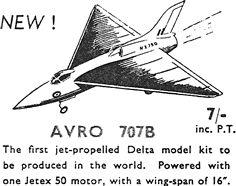
- Model Aircraft, Sep. 1951
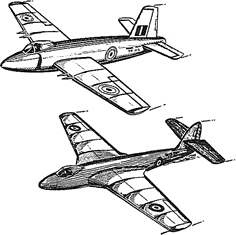
- Phil Smith
|
|||||||||||||||||||||||||||||||||||||||||||||||||||||||||||||||||||||
|
|
||||||||||||||||||||||||||||||||||||||||||||||||||||||||||||||||||||||
|
|
|
|||||||||||||||||||||||||||||||||||||||||||||||||||||||||||||||||||||
|
|
|
|
|
|
|
|
Acknowledgements - Article: Roger Simmonds - Illustrations: Roger Simmonds, Phil Smith, Peter Tolhurst, MAAC archives via Bill Henderson |
|
|
|
|
ABOUT | MOTORS | MODELS | ARCHIVE | HISTORY | STORE | FAQ | LINKS |
|
|
Terms of Use
|
Queries? Corrections? Additions?
Please
contact us.
|
|